Related Research Articles
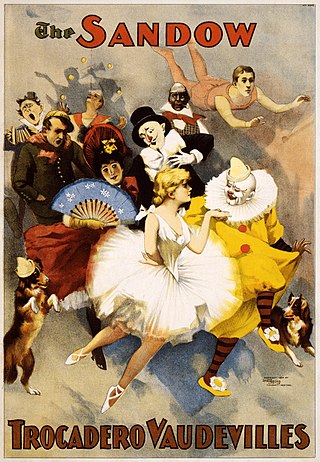
Vaudeville is a theatrical genre of variety entertainment which began in France at the end of the 19th century. A vaudeville was originally a comedy without psychological or moral intentions, based on a comical situation: a dramatic composition or light poetry, interspersed with songs or ballets. It became popular in the United States and Canada from the early 1880s until the early 1930s, while changing over time.
Female impersonation is a type of theatrical performance where a man dresses in women's clothing for the sole purpose of entertaining an audience. While the term female impersonator is sometimes used interchangeably with drag queen, they are not the same. Drag as an art form is associated with queer identity whereas female impersonation may come from a wide a range of gender identity paradigms, including heteronormativity. Additionally, many drag artists view drag as a lived form of self-expression or creativity, and perceive drag as something that is not limited to the stage or to performance. In contrast, female impersonation is specifically limited to performance and may or may not involve an LGBTQI point of view.

Pioneer Square is a neighborhood in the southwest corner of Downtown Seattle, Washington, US. It was once the heart of the city: Seattle's founders settled there in 1852, following a brief six-month settlement at Alki Point on the far side of Elliott Bay. The early structures in the neighborhood were mostly wooden, and nearly all burned in the Great Seattle Fire of 1889. By the end of 1890, dozens of brick and stone buildings had been erected in their stead; to this day, the architectural character of the neighborhood derives from these late 19th century buildings, mostly examples of Richardsonian Romanesque.

The Iroquois Theatre fire was a catastrophic building fire in Chicago, Illinois, that broke out on December 30, 1903, during a performance attended by 1,700 people. The fire caused 602 deaths and 250 non-fatal injuries. It ranks as the worst theater fire in the United States, surpassing the carnage of the Brooklyn Theatre fire of 1876, which claimed at least 278 lives.
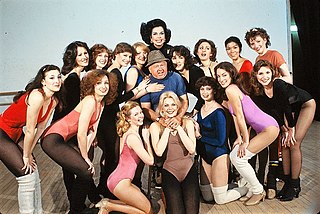
Sugar Babies is a musical revue conceived by Ralph G. Allen and Harry Rigby, with music by Jimmy McHugh, lyrics by Dorothy Fields and Al Dubin and various others. The show is a tribute to the old burlesque era. First produced in 1979 on Broadway and running nearly three years, the revue attracted warm notices and was given subsequent touring productions.

Seattle is a significant center for the painting, sculpture, textile and studio glass, alternative, urban art, lowbrow and performing arts. The century-old Seattle Symphony Orchestra is among the world's most recorded orchestras. The Seattle Opera and Pacific Northwest Ballet, are comparably distinguished. On at least two occasions, Seattle's local popular music scene has burst into the national and even international consciousness, first with a major contribution to garage rock in the mid-1960s, and later as the home of grunge rock in the early 1990s. The city has about twenty live theater venues, and Pioneer Square is one of the country's most prominent art gallery districts.
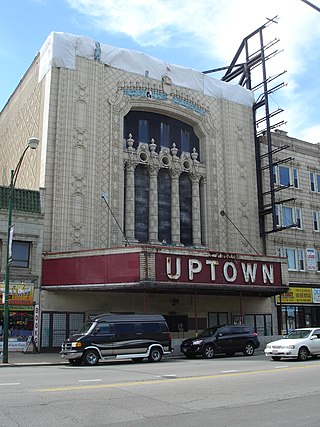
A movie palace is a large, elaborately decorated movie theater built from the 1910s to the 1940s. The late 1920s saw the peak of the movie palace, with hundreds opening every year between 1925 and 1930. With the advent of television, movie attendance dropped, while the rising popularity of large multiplex chains in the 1980s and 1990s signaled the obsolescence of single-screen theaters. Many movie palaces were razed or converted into multiple-screen venues or performing arts centers, though some have undergone restoration and reopened to the public as historic buildings.

The Palace Theatre is a Broadway theater at 1564 Broadway, at the north end of Times Square, in the Midtown Manhattan neighborhood of New York City. Designed by Milwaukee architects Kirchhoff & Rose, the theater was funded by Martin Beck and opened in 1913. From its opening to about 1929, the Palace was considered among vaudeville performers as the flagship venue of Benjamin Franklin Keith and Edward Franklin Albee II's organization. The theater had 1,648 seats across three levels as of 2018.
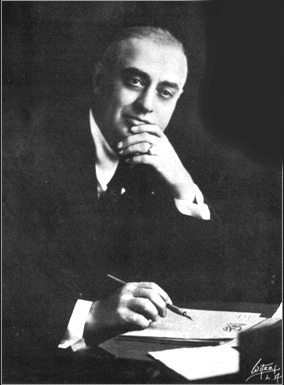
Alexander Pantages was a Greek American vaudeville impresario and early motion picture producer. He created a large and powerful circuit of theatres across the Western United States and Canada.

The Paramount Theatre is a 2,807-seat performing arts venue located at 9th Avenue and Pine Street in the downtown core of Seattle, Washington, United States. The theater originally opened on March 1, 1928, as the Seattle Theatre, with 3,000 seats. It was placed on the National Register of Historic Places on October 9, 1974, and has also been designated a City of Seattle landmark.

Avalon is a historic nightclub in Hollywood, California, located near the intersection of Hollywood and Vine, at 1735 N. Vine Street. It has previously been known as The Hollywood Playhouse, The WPA Federal Theatre, El Capitan Theatre, The Jerry Lewis Theatre, The Hollywood Palace and The Palace. It has a capacity of 1,500, and is located across the street from the Capitol Records Building.

The Copernicus Center is a 1,852-seat former movie palace that is now part of the Copernicus Center in the Jefferson Park community area of Chicago in Cook County, Illinois, United States. The Copernicus Center is located at 5216 W. Lawrence Avenue.
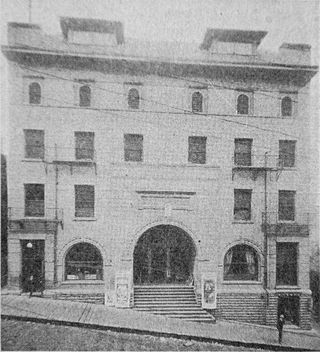
The Grand Opera House in Seattle, Washington, US, designed by Seattle architect Edwin W. Houghton, a leading designer of Pacific Northwest theaters, was once the city's leading theater. Today, only its exterior survives as the shell of a parking garage. Considered by the city's Department of Neighborhoods to be an example of Richardsonian Romanesque, the building stands just outside the northern boundary of the Pioneer Square neighborhood.
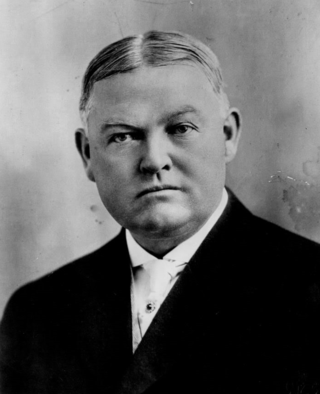
John W. Considine was an American impresario, a pioneer of vaudeville.

John Cort was an American impresario; his Cort Circuit was one of the first national theater circuits. Along with John Considine and Alexander Pantages, Cort was one of the Seattle-based entrepreneurs who parlayed their success in the years following the Klondike Gold Rush into an impact on America's national theater scene. While Considine and Pantages focused mainly on vaudeville, Cort focused on legitimate theater. At one time, he owned more legitimate theaters than anyone else in the United States, and he eventually became part of the New York theatrical establishment. His Cort Theatre remains a fixture of Broadway.

The Nifty Theatre in Waterville, Washington is a small movie theater. The 1919 frame building features Mission Style detailing, and seats just under 300. The theater ceased operations in 1959 and had been used as a storage building until 1997, when new owners restored the theater for community use.
John Hamrick (1875–1956) was an American entrepreneur in the theater business. He leased and owned a large number of vaudeville and movie theaters in the Northwest from at least the early 1920s until the late 1940s. Hamrick lived in Seattle, Washington and eventually assembled a string of theaters that included the Rex Theatre, which he was in charge of as early as 1913. the Oriental Theatre in Portland, Oregon, the Beverly, several Blue Mouse Theatres, the Music Box Theatre, the Riviera Theatre, and the Roxy Theatre. Hamrick also owned several theaters in Seattle and is generally credited as being the first Seattle theater owner to show "talking pictures."
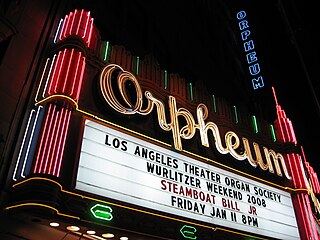
The Orpheum Circuit was a chain of vaudeville and movie theaters. It was founded in 1886, and operated through 1927 when it was merged into the Keith-Albee-Orpheum corporation, ultimately becoming part of the Radio-Keith-Orpheum (RKO) corporation.

The Pantages Theatre or Jones Building in Tacoma, Washington was designed by the architect B. Marcus Priteca. The unusual structure opened in January 1918. However, the theatre was commissioned in 1916 by the theatre manager Alexander Pantages. It was designed to be an office building and a vaudeville theatre. The theater's Second Renaissance Revival style is juxtaposed with the Commercial style. The exterior above the ground floor is largely unaltered. The building still houses entertainment and commercial activities A brief overview of the owner and renovation history, in 1916–1918, B. Marcus Priteca with Edwin W. Houghton; 1955 remodel, Carlson, Eley, and Grevstad; 1982–1983 renovation, Richard F. McCann; 2006 entrance/lobby renovation, Korth Sunseri Hagey and Grulich Architecture and Planning; 2014 stage expansion and structural renovations, BCRA. 901 Broadway.

The Orpheum Theatre, originally opened in August 1916, stands on Kellogg Street in downtown Galesburg, Illinois. The Orpheum's elegance and long history made the theatre a landmark in Galesburg which boasts other landmarks such as Carl Sandburg's Birthplace, the Galesburg Railroad Museum, and Knox College, which hosted an Abraham Lincoln-Stephen Douglas debate.
References
- Murray Morgan, Skid Road, Ballantine Books (1960).